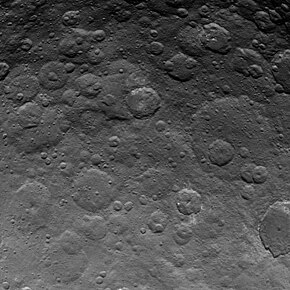
Vesta is one of the largest objects in the asteroid belt, with a mean diameter of 525 kilometres (326 mi). It was discovered by the German astronomer Heinrich Wilhelm Matthias Olbers on 29 March 1807 and is named after Vesta, the virgin goddess of home and hearth from Roman mythology.
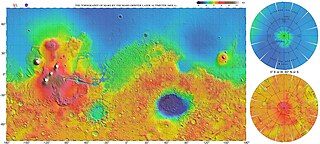
The North Polar Basin, more commonly known as the Borealis Basin, is a large basin in the northern hemisphere of Mars that covers 40% of the planet. Some scientists have postulated that the basin formed during the impact of a single, large body roughly 2% of the mass of Mars, having a diameter of about 1,900 km early in the history of Mars, around 4.5 billion years ago. However, the basin is not currently recognized as an impact basin by the IAU. The basin is one of the flattest areas in the Solar System, and has an elliptical shape.

Ceres is a dwarf planet in the middle main asteroid belt between the orbits of Mars and Jupiter. It was the first known asteroid, discovered on 1 January 1801 by Giuseppe Piazzi at Palermo Astronomical Observatory in Sicily, and announced as a new planet. Ceres was later classified as an asteroid and then a dwarf planet, the only one not beyond Neptune's orbit.
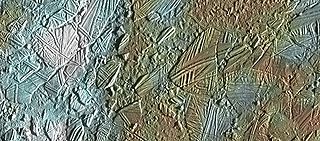
In astrogeology, chaos terrain, or chaotic terrain, is a planetary surface area where features such as ridges, cracks, and plains appear jumbled and enmeshed with one another. Chaos terrain is a notable feature of the planets Mars and Mercury, Jupiter's moon Europa, and the dwarf planet Pluto. In scientific nomenclature, "chaos" is used as a component of proper nouns.

The Diacria quadrangle is one of a series of 30 quadrangle maps of Mars used by the United States Geological Survey (USGS) Astrogeology Research Program. The quadrangle is located in the northwestern portion of Mars' western hemisphere and covers 180° to 240° east longitude and 30° to 65° north latitude. The quadrangle uses a Lambert conformal conic projection at a nominal scale of 1:5,000,000 (1:5M). The Diacria quadrangle is also referred to as MC-2. The Diacria quadrangle covers parts of Arcadia Planitia and Amazonis Planitia.

The Eridania quadrangle is one of a series of 30 quadrangle maps of Mars used by the United States Geological Survey (USGS) Astrogeology Research Program. The Eridania quadrangle is also referred to as MC-29.
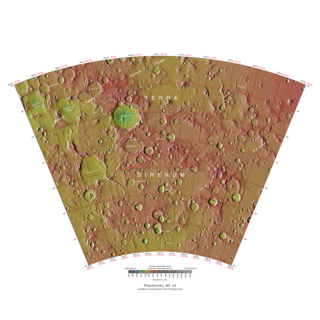
The Phaethontis quadrangle is one of a series of 30 quadrangle maps of Mars used by the United States Geological Survey (USGS) Astrogeology Research Program. The Phaethontis quadrangle is also referred to as MC-24.
Chaos terrain on Mars is distinctive; nothing on Earth compares to it. Chaos terrain generally consists of irregular groups of large blocks, some tens of kilometers across and a hundred or more meters high. The tilted and flat topped blocks form depressions hundreds of metres deep. A chaotic region can be recognized by a rat's nest of mesas, buttes, and hills, chopped through with valleys which in places look almost patterned. Some parts of this chaotic area have not collapsed completely—they are still formed into large mesas, so they may still contain water ice. Chaos regions formed long ago. By counting craters and by studying the valleys' relations with other geological features, scientists have concluded the channels formed 2.0 to 3.8 billion years ago.

Several bright surface features were discovered on the dwarf planet Ceres by the Dawn spacecraft in 2015.

In summer 1965, the first close-up images from Mars showed a cratered desert with no signs of water. However, over the decades, as more parts of the planet were imaged with better cameras on more sophisticated satellites, Mars showed evidence of past river valleys, lakes and present ice in glaciers and in the ground. It was discovered that the climate of Mars displays huge changes over geologic time because its axis is not stabilized by a large moon, as Earth's is. Also, some researchers maintain that surface liquid water could have existed for periods of time due to geothermal effects, chemical composition, or asteroid impacts. This article describes some of the places that could have held large lakes.

Occator is an impact crater located on Ceres, the largest object in the main asteroid belt that lies between the orbits of Mars and Jupiter, that contains "Spot 5", the brightest of the bright spots observed by the Dawn spacecraft. It was known as "Region A" in ground-based images taken by the W. M. Keck Observatory on Mauna Kea.
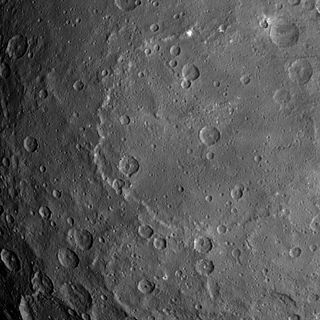
Kerwan is the largest confirmed crater and one of the largest geological features on Ceres. It was discovered on February 19, 2015 from Dawn images as it approached Ceres. The crater is distinctly shallow for its size, and lacks a central peak. A central peak might have been destroyed by a 15-kilometer-wide crater at the center of Kerwan. The crater is likely to be young relative to the rest of Ceres's surface, as Kerwan has largely obliterated the cratering in the southern part of Vendimia Planitia.
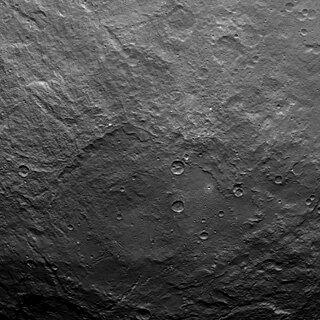
Yalode is the second-largest confirmed crater on Ceres, after Kerwan. It is adjacent to another large crater, Urvara and serves as the namesake for the Yalode Quadrange. Yalode named after the Dahomeyan (Fon) deity of the yam harvest, Yalodé; the name Yalode was officially approved by the International Astronomical Union (IAU) on 3 July 2015.
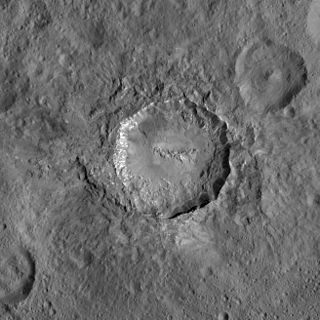
Haulani is an impact crater located on Ceres that contains "Spot 1", one of the bright spots observed by the Dawn spacecraft. The crater was named after Haulani, the Hawaiian goddess of plants. In July 2018, NASA released a comparison of physical features, including Haulani crater, found on Ceres with similar ones present on Earth.

Dantu is a large crater on Ceres, located within the Vendimia Planitia. It is rimmed by a number of minor faculae, which together form Bright Spot 2.

Fejokoo is a hexagonal impact crater on the dwarf planet Ceres. Like all craters on Ceres, it is named after an agricultural deity; the crater is named for the Igbo deity who provided yams. The name was officially approved by the International Astronomical Union (IAU) on 3 July 2015, shortly after Dawn had entered Ceres orbit. Fejokoo Crater is the namesake for the Fejokoo Quadrangle.

The geology of Ceres is the scientific study of the surface, crust, and interior of the dwarf planet Ceres. It seeks to understand and describe Ceres' composition, landforms, evolution, and physical properties and processes. The study draws on fields such as geophysics, remote sensing, geochemistry, geodesy, and cartography.

Achita is a large impact crater on the dwarf planet Ceres. The crater is named after Achita, a Nigerian god of agriculture. The crater was imaged as part of NASA's Dawn mission. The probe showed that Achita has mass-wasting ridges on the floor and is the fourth oldest crater on Ceres having been formed 570 million years ago.

Nawish is an impact crater on the dwarf planet Ceres. It is named after the Acoma guardian of the field. The name was officially approved by the International Astronomical Union (IAU) on 3 July 2015. It is the namesake of the Nawish Quadrangle.

Sintana is a large central peak crater in the Southern Hemisphere of the dwarf planet Ceres, located at 44.21° S, 76.4 ° E. It has a diameter of 58 km, hosting a central peak. The crater is named after the deity of the Kogi people of northern Colombia who produced fertile black earth. The name Sintana was officially adopted by the International Astronomical Union (IAU) on 3 July 2015. It is the namesake of the Sintana Quadrangle.
